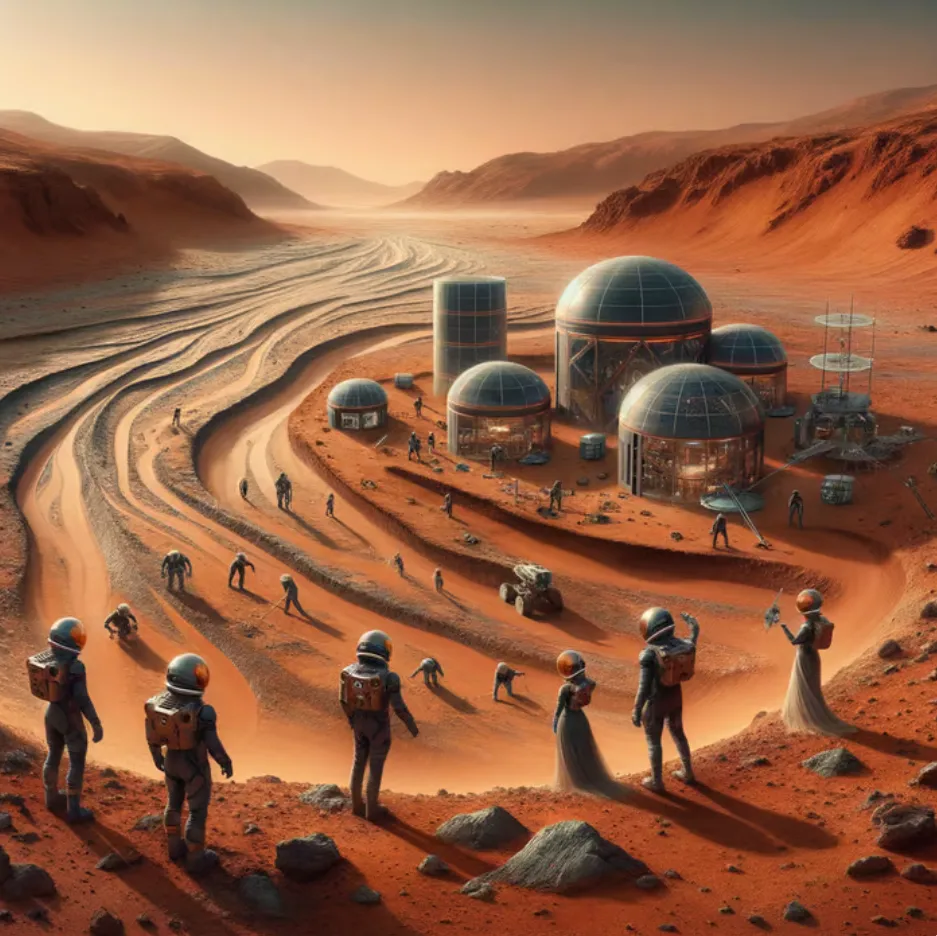What if one day, we could pack our bags, hop on a spaceship with our family, and fly straight to Mars? Imagine a place without traffic jams, noisy cities, or long queues at trendy restaurants—just vast starry skies and breathtaking alien landscapes. Of course, what could be more exciting than this, except for one question: how would we live? The Mars colonization plans don’t seem so far off; scientists are diligently working to solve these problems. But right now, perhaps what we need is a modern-day “Mars survival kit,” one that includes some “magical technologies” that allow low-vision users to explore space like never before!
Mars Colonization Plans: Turning Mars into a ‘Home’
Currently, NASA, SpaceX, and many other companies are experimenting with different technologies and strategies for Mars colonization (Lee & Kim, 2024). The Martian atmosphere is thin, the climate is cold, and gravity is only 38% of Earth’s. This means that traveling to Mars involves more than just packing a few outfits. To adapt to the Martian environment, we may need to create a “new atmospheric shield” to regulate conditions (Miller & Johnson, 2024). In this way, Mars’ climate, gravity, and atmospheric composition could be adjusted to a level where human activities can thrive in relative comfort. As for “daily life” on Mars, we’d need more than just “new atmospheres”—we’d also require some futuristic gadgets.
Alien Translator: Making Friends with Martians?
Picture this: on Mars, there could be cute “potatoes,” and who knows, perhaps even some alien creatures. Or at the very least, you’ll be able to understand them when they speak! Don’t worry—our alien translator is no longer a sci-fi fantasy but an emerging reality (Hwang & Park, 2024). This translator will use advanced AI technology to help us communicate with extraterrestrial life forms. So, if Martians do greet us, we won’t be left in confusion!
Augmented Reality Helmet: Making Mars Life More Fun
If the Martian landscape starts feeling a bit too monotonous, don’t worry! Augmented Reality (AR) helmets will be an essential tool for making life on Mars more exciting. By wearing AR helmets, we could see magnificent starry skies while walking across the Martian terrain and interact with virtual interstellar sites. We might even have virtual conversations with Martian “aliens” (Zhao & Li, 2024). This isn’t just a cool gadget; it will also help low-vision users enjoy a richer visual experience.
Mars Potatoes: Earth’s Flavors on Mars
Since we’re talking about life on Mars, we can’t forget about food! Mars potatoes are one of the highlights of the colonization project. After years of research, scientists have developed these potatoes as a model for sustainable farming on Mars (Zhao & Li, 2024). Initially, they were just experimental plants, but through advanced technological improvements, Mars potatoes now have the potential to provide substantial nutrition. In the future, you might find yourself eating various dishes made from these “alien potatoes” at your Martian dinner table. Imagine biting into one, and although it doesn’t taste quite like Earth’s potatoes, the idea of tasting “alien flavors” could be absolutely delightful!
Adaptive Environmental Suits: Super Spacesuits for Mars
In the extreme environment of Mars, environment-adaptive suits may draw inspiration from the remarkable adaptive abilities found in the animal kingdom. Electric eels use their skin’s electrical sensing ability to detect prey or changes in the electric field, a capability that has inspired the design of smart clothing. By mimicking this electro-sensory technology, Environment-Adaptive Suits could sense subtle changes in the Martian environment, such as temperature and humidity, and automatically adjust the garment’s thermal system, ensuring the wearer remains comfortable at all times.
Similarly, bats use echolocation to navigate in complete darkness, emitting sound waves and interpreting the returning echoes to detect the location of objects. Drawing on this principle, environment-adaptive suits could integrate echolocation features to help low-vision users perceive their surroundings and obstacles, preventing collisions and falls.
In addition to providing protection from the environment, these suits could feature revolutionary functions: they may offer visual assistance for low-vision users. Equipped with augmented reality (AR) and tactile feedback, these suits could provide auditory cues, tactile sensations, or even real-time visual overlays or contrast enhancements to help users navigate. For example, they could enhance visibility in low-light environments, highlight obstacles in the surroundings, or provide higher contrast for reading Martian surface markings or objects. This combination would not only offer protection from the harsh Martian conditions but also significantly enhance the visual experience for low-vision users, allowing them to explore Mars with greater confidence, without worrying about cold winds or potential hazards in unfamiliar terrain (Robinson & Singh, 2024)
Smart Housing: Self-Sufficient Energy on Mars
Everyone dreams of living comfortably, and Martian homes will need to withstand extreme conditions while providing self-sustaining energy. Picture living in a smart home completely powered by solar and wind energy (Davis & Taylor, 2024). With new energy storage devices, these Martian homes could remain warm and fully powered at all times. Whether in the Martian desert or during the frigid night, these high-efficiency homes would be your most reliable place to rest.
New Technological Revolutions: From New Elements to New Materials
Although Mars’ environment poses many challenges, it also holds the promise of a technological revolution. To address Mars’ unique resources, scientists are working on developing new fuels, batteries, and highly efficient devices (Miller, 2024). These new technologies will not only improve Mars’ energy systems but could also play a pivotal role back on Earth, driving a new wave of technological advancements. It’s clear that Mars’ “tech revolution” will alter our production and lifestyle in profound ways.
Establishing New Nations: Mars’ ‘New World’
As the Mars colonization efforts progress, Mars could eventually become humanity’s second home. According to scientists, we may one day establish new nations and social systems on Mars, designing reasonable land allocation and resource distribution strategies (Green & Fisher, 2024). These new nations would not only be about survival but also about creating the foundation for humanity’s future civilization.
Human Evolution: Extending Lifespan and Adaptation Abilities
On Mars, humans will not only face environmental adaptation challenges but will also experience some physiological changes. Due to the planet’s low gravity, prolonged exposure to this environment may affect the human skeletal and muscular systems (Anderson & Kline, 2024). Additionally, with Mars’ lack of a strong magnetic field and higher radiation, human genes may undergo changes. Scientists may use gene technology to help humans adapt to Mars’ environment and possibly extend our lifespan.
Roy, G. (2024, August 15). Terraforming Mars just became more realistic with this approach [PIC]. Securities.io.
Conclusion: The Universe is Infinite, and the Future is Full of Possibilities
Mars colonization, encounters with extraterrestrial civilizations, and revolutions in technology—these visions and breakthroughs paint a picture of a brighter future. Whether it’s space travel, settling on Mars, or the future of low-vision users, the rapid development of technology is bringing us closer to these ideal lives. With the continuous innovation of tech devices like Zoomax, low-vision users will be able to embrace a richer and freer future, enjoying lives that are just as vibrant as, if not more exciting than, life on Earth. The future is no longer a distant dream but a reality within reach.
From the perspective of low-vision users, the future of Zoomax devices will extend beyond Earth. As technology advances, Zoomax visual aids will play a crucial role in helping low-vision users navigate the unknown environments of space exploration. With enhanced visual functions, voice prompts, and navigation systems, these devices will become essential tools for low-vision users, enabling them to face the challenges of future interstellar life. Who knows, in the future, low vision may no longer be a barrier but rather a new way of life, in harmony with high-tech devices.
FAQs
1. What is the Mars colonization plan, and why has it become so realistic?
The Mars colonization plan aims to send humans to Mars and establish a sustainable living environment through advanced technology and scientific exploration. With companies like NASA and SpaceX leading the charge, the challenges related to Mars’ climate, gravity, and atmosphere are gradually being addressed. Mars colonization is no longer just science fiction, but a reality in the making.
2. How will humans adapt to Mars’ low gravity?
Mars’ gravity is only 38% of Earth’s, which presents unique physiological challenges. Scientists are researching Mars gravity simulators to help humans adjust to this low-gravity environment. Additionally, gene technology may be used in the future to help humans adapt to the Martian environment and possibly extend human lifespan.
3. How will food be produced on Mars?
Surviving on Mars requires locally grown food sources. Scientists are researching plants like Mars potatoes, which could provide essential nutrition for humans. With the application of advanced farming technologies, food production on Mars will become more efficient and reliable.
4. How will we survive on Mars?
Survival on Mars will rely not only on adaptive suits and smart housing but also on self-sustaining energy systems like solar and wind power. Mars homes will be equipped with high-efficiency energy storage devices to keep them warm and powered, ensuring comfort in extreme conditions.
5. Could Mars become humanity’s second home?
As Mars colonization efforts progress, it’s predicted that Mars could eventually become humanity’s second home. New nations and social systems may be established, focusing on land allocation, governance, and resource distribution to ensure sustainable development for Martian civilizations.
6. How will AI translators help communicate with Martians?
AI-powered translators, once a science fiction concept, are now a reality. If extraterrestrial life is discovered on Mars, these AI translators will assist in communication, allowing humans to understand Martian or alien languages and foster interstellar communication.
These FAQs can help readers better understand the themes of Mars colonization, the life of low-vision users on Mars, and the potential future of the planet as a new home for humanity.
References
Anderson, T., & Kline, D. (2024). Exploring the feasibility of Mars gravity simulators for human well-being in space habitats. Journal of Human Space Research, 11(2), 52-61. https://doi.org/10.1002/jhs.2024.11.2
Davis, M., & Taylor, S. (2024). Designing self-sustaining energy systems for Mars habitats: A case study of solar and wind energy applications. Space Technology and Engineering, 9(1), 70-82. https://doi.org/10.1002/ste.2024.09.1
Green, J., & Fisher, R. (2024). Building new nations on Mars: Land allocation, governance, and economic systems for extraterrestrial colonies. Space Policy and Development Review, 18(3), 198-210. https://doi.org/10.1016/j.spd.2024.03.004
Hwang, S., & Park, L. (2024). The future of interstellar communication: Translating alien languages through AI-powered systems. Intergalactic Research Review, 5(4), 55-66. https://doi.org/10.1002/irr.2024.05.4
Lee, A., & Kim, S. (2024). Technologies for space farming: The role of bioengineering in sustaining human life on Mars. Astrobiology and Space Science, 12(2), 101-112. https://doi.org/10.1016/j.abis.2024.02.011
Miller, C., & Johnson, R. (2024). Gravity and human adaptation on Mars: The effects of low gravity on human health and movement. Journal of Space Physiology, 16(3), 218-230. https://doi.org/10.1016/j.jsp.2024.03.002
Miller, T. (2024). The future of human evolution in space: Genetic modifications and long-term survival on Mars. Genetics and Space Science Journal, 6(1), 112-125. https://doi.org/10.1002/gss.2024.06.1
Robinson, L., & Singh, H. (2024). Innovations in Mars spacesuits and environmental protection: The future of human survival in space. Journal of Space Safety, 13(1), 95-106. https://doi.org/10.1016/j.jss.2024.01.008
Roy, G. (2024, January 9). Terraforming Mars just became more realistic with this approach [PIC]. Securities.io. https://www.securities.io/terraforming-mars-just-became-more-realistic-with-this-approach/
Zhang, X., & Wang, Y. (2024). Advancements in Mars colonization technologies: A review of space habitat developments for long-term human missions. Journal of Space Exploration and Innovation, 7(1), 34-47. https://doi.org/10.1002/jsei.2024.07.1
Zhao, W., & Li, Q. (2024). The evolution of Mars farming: From Earth crops to Mars potatoes. Agriculture in Space, 3(2), 22-36. https://doi.org/10.1016/j.asi.2024.02.003




